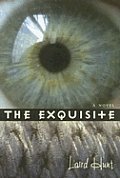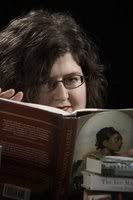 “Once upon a time I was someone and then that stopped.”
“Once upon a time I was someone and then that stopped.”Henry, a destitute New Yorker, is instructed by his friend Tulip to visit the apartment of Aris Kindt who has lots of things worth stealing. In truth, Tulip has sent him there to meet Mr. Kindt, who is seeking another member for his crew of assassins. The eccentric, herring-loving Mr. Kindt stages simulated murders for New Yorkers suffering from post-9/11 anxiety.
Or…
Henry, a destitute New Yorker is sinking into a life of vagrancy until the day he wanders into the path of a florist’s truck. At the hospital Henry’s daily visitor Mr. Kindt, also under the care of Dr. Tulp, convinces him to make money by stealing pharmaceuticals.
Is Henry living one life or two?
Laird Hunt’s new novel, The Exquisite, is stylishly noir. Alternating between the two stories of Henry, readers are presented with two potential realities. In both scenarios, Henry is a troubled, young homeless man. He is drawn into the orbit of Dutchman Aris Kindt, whose mysterious origins are somehow connected to the corpse depicted in Rembrandt’s painting, The Anatomy Lesson.
To review The Exquisite without revealing important details is difficult. Unlike many mysteries, there is no key “crime” which must be unraveled. Instead, readers must unravel Henry’s situation and, at the same time, the mystery of Aris Kindt.
 Any serious consideration of The Exquisite must consider the painting with which it is so closely connected. Hunt has given two of his key characters names from the painting. Aris Kindt is a criminal like his namesake and Dr. Tulp, Henry’s doctor at the hospital, bears the same name as the anatomist from the painting. Sprinkled throughout are hints that there are closer ties to the painting than just character names.
Any serious consideration of The Exquisite must consider the painting with which it is so closely connected. Hunt has given two of his key characters names from the painting. Aris Kindt is a criminal like his namesake and Dr. Tulp, Henry’s doctor at the hospital, bears the same name as the anatomist from the painting. Sprinkled throughout are hints that there are closer ties to the painting than just character names.According to A.C. Masquelet, Rembrandt is not portraying a typical anatomy [dissection] lesson. “This is not a static, descriptive anatomy lesson, but a lesson in physiology and functional anatomy. It also displays one of the essential qualities of Rembrandt’s genius: the depiction of movement.”
So with this interpretation of Rembrandt’s painting in mind, how does Hunt mirror these concepts in The Exquisite? Hunt focuses on the nature and meaning of identity and death. The movement in Hunt’s novel comes from Henry’s shifting understanding of connections and relationships. As Henry tries to dissect the changing patterns of his relationships, and the power dynamics swirling around him, the reader is forced to question Henry’s reliability as a narrator and determiner of truth.
While readers may initially focus on determining what is “real” in Henry’s situation, what will linger is Hunt’s playful use of language. He uses unusual descriptions, “the lamplight loving away at her cheekbones,” and frequent repetition to create a tide of words meant to sweep away his readers. At one point, Aris describes Rembrandt’s painting to Henry: “Then it became, in its combination of spectacle and fervid speculation, quite blurred.” He could easily be describing what Laird Hunt has achieved with The Exquisite.
ISBN10: 1566891876
ISBN13: 9781566891875
Trade Paperback
256 Pages
Publisher: Coffee House Press
Publication Date: September 1, 2006
Author Website: www.lairdhunt.net
Coffee House Press - Where Good Books are Brewing
About the Coffee House Press:
Coffee House Press is an award-winning, nonprofit literary publisher. We produce books that present the dreams and ambitions of people who have been underrepresented in published literature, books that shape our national consciousness while strengthening a larger sense of community.
Coffee House Press was founded in 1984, and took its name from the long tradition of coffee houses as places for the free exchange of ideas, where each individual had equal time for expression, regardless of station or background. The English coffee house of the 1600s was a place of fellowship and discussion of the events of the day. The Parisian cafes of the early 1900s witnessed the birth of Dadaism, cubism, and surrealism. The American coffee house of the 1950s, a refuge from conformity for beat poets, exploded with literary energy. This spirit lives on in the pages of Coffee House Press books.
tags: books small press book reviews Laird Hunt


2 comments:
You've sold me! Sounds fascinating!
Nice one, Janelle!
Post a Comment